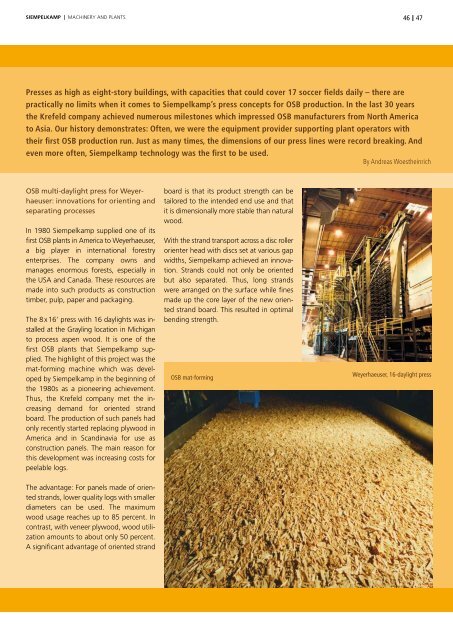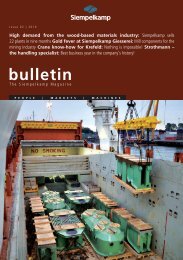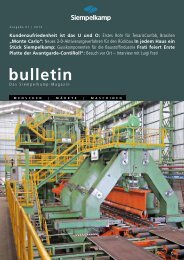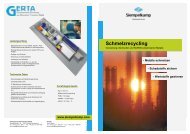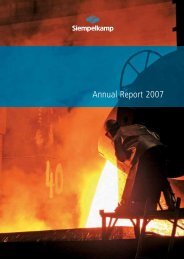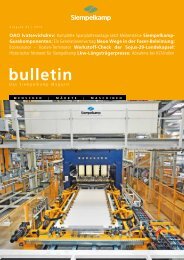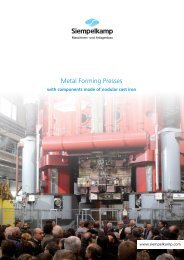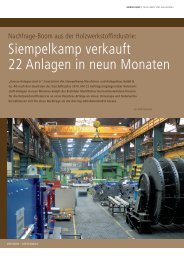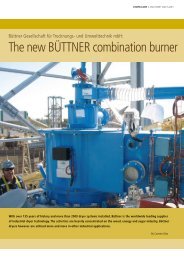Bulletin 1/2011 - Siempelkamp
Bulletin 1/2011 - Siempelkamp
Bulletin 1/2011 - Siempelkamp
Create successful ePaper yourself
Turn your PDF publications into a flip-book with our unique Google optimized e-Paper software.
SieMpelkaMp | MACHInERy AnD PLAntS<br />
Presses as high as eight-story buildings, with capacities that could cover 17 soccer fields daily – there are<br />
practically no limits when it comes to <strong>Siempelkamp</strong>’s press concepts for OSB production. In the last 30 years<br />
the Krefeld company achieved numerous milestones which impressed OSB manufacturers from North America<br />
to Asia. Our history demonstrates: Often, we were the equipment provider supporting plant operators with<br />
their first OSB production run. Just as many times, the dimensions of our press lines were record breaking. And<br />
even more often, <strong>Siempelkamp</strong> technology was the first to be used.<br />
By Andreas Woestheinrich<br />
OSB multi-daylight press for Weyerhaeuser:<br />
innovations for orienting and<br />
separating processes<br />
In 1980 <strong>Siempelkamp</strong> supplied one of its<br />
first OSB plants in America to Weyerhaeuser,<br />
a big player in international forestry<br />
enterprises. the company owns and<br />
manages enormous forests, especially in<br />
the USA and Canada. these resources are<br />
made into such products as construction<br />
timber, pulp, paper and packaging.<br />
the 8 x 16’ press with 16 daylights was installed<br />
at the Grayling location in Michigan<br />
to process aspen wood. It is one of the<br />
first OSB plants that <strong>Siempelkamp</strong> supplied.<br />
the highlight of this project was the<br />
mat-forming machine which was developed<br />
by <strong>Siempelkamp</strong> in the beginning of<br />
the 1980s as a pioneering achievement.<br />
thus, the Krefeld company met the increasing<br />
demand for oriented strand<br />
board. the production of such panels had<br />
only recently started replacing plywood in<br />
America and in Scandinavia for use as<br />
construction panels. the main reason for<br />
this development was increasing costs for<br />
peelable logs.<br />
the advantage: For panels made of oriented<br />
strands, lower quality logs with smaller<br />
diameters can be used. the maximum<br />
wood usage reaches up to 85 percent. In<br />
contrast, with veneer plywood, wood utilization<br />
amounts to about only 50 percent.<br />
A significant advantage of oriented strand<br />
board is that its product strength can be<br />
tailored to the intended end use and that<br />
it is dimensionally more stable than natural<br />
wood.<br />
With the strand transport across a disc roller<br />
orienter head with discs set at various gap<br />
widths, <strong>Siempelkamp</strong> achieved an innovation.<br />
Strands could not only be oriented<br />
but also separated. thus, long strands<br />
were arranged on the surface while fines<br />
made up the core layer of the new oriented<br />
strand board. this resulted in optimal<br />
bending strength.<br />
OSB mat-forming<br />
46<br />
47<br />
Weyerhaeuser, 16-daylight press


